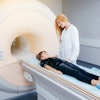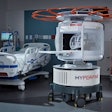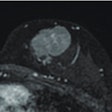Thursday, December 1 | 9:20 a.m.-9:30 a.m. | MSVB51-05 | Room E451B
Three-tesla breast MRI appears slightly better than 1.5-tesla in detecting suspicious lesions in patients with newly diagnosed breast cancer, according to researchers at Yale University.In this Thursday morning session, Dr. Reena Vashi and colleagues will present data from a study they conducted to compare the two technologies. The study included 95 consecutive 3-tesla MR examinations and 86 consecutive 1.5-tesla MR examinations performed between July 2009 and April 2010 in patients with newly diagnosed breast cancer.
In the 3-tesla MRI group, 115 suspicious lesions were identified in 60% of patients; 87% of these lesions were biopsied. In the 1.5-tesla group, 67 suspicious lesions were identified in 47% of patients and 92% of these lesions were biopsied. As for biopsy results, 3-tesla MRI yielded 24% additional malignancies compared with 1.5-tesla's 18%, 55% versus 55% for benign lesions, and 21% versus 27% for high-risk lesions. Three-tesla breast MRI found additional cancers in 28% of the patients who underwent biopsy, while 1.5-tesla found additional cancers in 26%.
In patients newly diagnosed with breast cancer, 3-tesla breast MRI detected more suspicious lesions, but overall performance between the two magnet strengths was similar for detecting additional cancers proved by pathology, Vashi and colleagues concluded.




.fFmgij6Hin.png?auto=compress%2Cformat&fit=crop&h=100&q=70&w=100)




.fFmgij6Hin.png?auto=compress%2Cformat&fit=crop&h=167&q=70&w=250)











